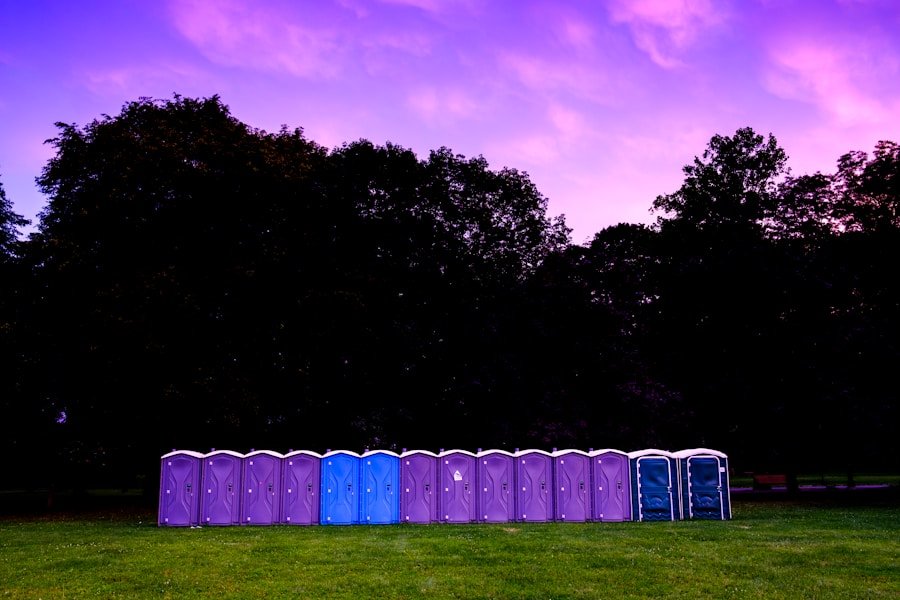When embarking on a remote camping adventure, it is crucial to prioritize hygiene to ensure a safe and enjoyable experience. In remote locations, access to traditional restroom facilities is often limited or non-existent, making it necessary to find alternative solutions for maintaining cleanliness. Portable toilets offer a convenient and effective way to address this need, allowing campers to stay fresh and clean even in the most remote of locations.
By providing a designated area for waste disposal, portable toilets help to minimize the impact of human activity on the surrounding environment, while also promoting a more sanitary camping experience for all. In addition to the environmental benefits, portable toilets also contribute to the overall comfort and convenience of remote camping trips. Without access to traditional restroom facilities, campers may find themselves facing uncomfortable and unsanitary conditions.
Portable toilets provide a practical solution to this problem, offering a clean and private space for campers to attend to their personal hygiene needs. By ensuring that these basic needs are met, portable toilets help to enhance the overall camping experience, allowing individuals to focus on enjoying the natural beauty of their surroundings without the distraction of discomfort or inconvenience.
Key Takeaways
- Proper hygiene is crucial in remote camping to prevent illness and maintain comfort.
- Portable toilets offer convenience and comfort, making it easier to stay clean and fresh while camping.
- Using portable toilets in remote locations helps minimize environmental impact and preserve the natural surroundings.
- Maintaining cleanliness in the outdoors is essential for health and safety while camping.
- Choosing the right portable toilet and following proper usage and maintenance tips can greatly enhance the remote camping experience.
Convenience and Comfort: The Advantages of Portable Toilets
One of the primary benefits of using portable toilets in remote camping locations is the convenience and comfort they provide. Unlike traditional restroom facilities, which may be located miles away from a campsite, portable toilets can be easily transported and set up in close proximity to where they are needed. This eliminates the need for campers to trek long distances in search of a restroom, allowing them to attend to their personal hygiene needs quickly and easily.
Additionally, portable toilets offer a level of privacy that may be lacking in more open or communal restroom facilities, providing campers with a sense of comfort and security as they take care of their business. Furthermore, portable toilets are designed to be user-friendly and easy to maintain, making them an ideal solution for remote camping trips. Many models are equipped with features such as waste tanks and flushing mechanisms, which help to minimize odors and keep the unit clean and sanitary.
This not only benefits the individuals using the portable toilet, but also helps to maintain a more pleasant and hygienic environment for all campers in the vicinity. With their practical design and ease of use, portable toilets offer a convenient and comfortable solution for addressing the hygiene needs of remote campers.
Environmental Impact: Using Portable Toilets in Remote Locations
In addition to the personal benefits they provide, portable toilets also offer significant environmental advantages when used in remote camping locations. Without access to traditional restroom facilities, campers may resort to relieving themselves in the surrounding wilderness, which can have detrimental effects on the local ecosystem. Human waste left untreated in natural environments can contaminate water sources, harm wildlife, and contribute to the spread of disease.
Portable toilets help to mitigate these risks by providing a contained and sanitary means of waste disposal, reducing the impact of human activity on the surrounding environment. Furthermore, many modern portable toilets are designed with sustainability in mind, utilizing eco-friendly materials and waste management systems. Some models are equipped with biodegradable waste bags or composting capabilities, which allow for the safe and environmentally responsible disposal of waste.
By using portable toilets in remote camping locations, individuals can minimize their ecological footprint and help to preserve the natural beauty of the wilderness for future generations to enjoy. In this way, portable toilets offer a practical and sustainable solution for addressing the hygiene needs of remote campers while also protecting the environment.
Health and Safety: Maintaining Cleanliness in the Outdoors
| Benefits of Portable Toilets in Remote Camping Locations |
|---|
| 1. Improved sanitation |
| 2. Convenience for campers |
| 3. Environmental protection |
| 4. Minimizes human waste pollution |
| 5. Reduces spread of diseases |
Maintaining proper hygiene is essential for safeguarding the health and safety of individuals during remote camping trips. Without access to clean restroom facilities, campers may be at risk of exposure to harmful bacteria and pathogens that can lead to illness or infection. Portable toilets provide a hygienic and controlled environment for waste disposal, reducing the likelihood of contamination and promoting a healthier camping experience for all.
By using portable toilets, campers can minimize their exposure to potential health hazards and enjoy greater peace of mind as they explore the great outdoors. In addition to protecting personal health, portable toilets also contribute to the overall safety of remote camping trips by minimizing the risk of accidents or injuries. When nature calls, individuals may find themselves navigating uneven terrain or unfamiliar surroundings in search of a suitable place to relieve themselves.
This can increase the likelihood of slips, falls, or encounters with wildlife, posing potential dangers to campers. Portable toilets offer a safe and stable alternative, providing a designated area for waste disposal that is free from hazards and easily accessible. By using portable toilets in remote camping locations, individuals can prioritize their health and safety while enjoying a more secure and worry-free outdoor experience.
Choosing the Right Portable Toilet for Your Camping Trip
When selecting a portable toilet for a remote camping trip, it is important to consider factors such as size, capacity, and functionality to ensure that it meets the specific needs of the individuals using it. There are a variety of portable toilet options available, ranging from basic bucket-style models to more advanced flushable units with waste tanks. Campers should assess their requirements in terms of capacity and convenience, taking into account the number of people in their group and the duration of their trip.
Additionally, individuals should consider features such as odor control, ease of maintenance, and portability when choosing a portable toilet that best suits their needs. Furthermore, individuals should also be mindful of any regulations or guidelines regarding waste disposal in their chosen camping location when selecting a portable toilet. Some areas may have specific requirements for waste management or restrictions on certain types of portable toilets, so it is important to research these considerations beforehand.
By choosing a portable toilet that aligns with both personal preferences and environmental regulations, campers can ensure that they are making a responsible and informed decision for their remote camping trip.
Tips for Properly Using and Maintaining Portable Toilets
To maximize the benefits of using portable toilets in remote camping locations, individuals should follow best practices for proper usage and maintenance. This includes regularly emptying waste tanks or bags as needed to prevent overflow or odors, as well as cleaning the unit with mild disinfectants to ensure a sanitary environment. Campers should also be mindful of proper waste disposal procedures, following any guidelines or regulations set forth by the camping area to minimize their impact on the environment.
Additionally, individuals should take care to properly secure and store their portable toilet when not in use to prevent damage or contamination. This may involve sealing waste tanks or bags tightly and storing them in a designated area away from food or living spaces. By following these tips for proper usage and maintenance, campers can ensure that their portable toilet remains clean, functional, and effective throughout their remote camping trip.
The Freedom to Explore: How Portable Toilets Enhance Remote Camping Experiences
Ultimately, the use of portable toilets in remote camping locations offers individuals the freedom to explore and enjoy the great outdoors without compromising on hygiene or comfort. By providing a convenient and sanitary solution for waste disposal, portable toilets enable campers to focus on experiencing nature without the distraction of discomfort or inconvenience. Whether embarking on a multi-day hiking excursion or setting up a base camp in a secluded wilderness area, individuals can enjoy greater peace of mind knowing that their hygiene needs are being met through the use of portable toilets.
Furthermore, portable toilets contribute to a more sustainable and responsible approach to outdoor recreation by minimizing the impact of human activity on the environment. By using portable toilets in remote camping locations, individuals can help preserve the natural beauty of these areas for future generations while also promoting a healthier and safer outdoor experience for all. In this way, portable toilets enhance remote camping experiences by providing individuals with the tools they need to stay fresh and clean while exploring the wonders of nature.
In conclusion, portable toilets offer numerous benefits for individuals embarking on remote camping adventures. From promoting personal hygiene and comfort to minimizing environmental impact and enhancing safety, portable toilets provide a practical solution for addressing the hygiene needs of campers in even the most remote of locations. By choosing the right portable toilet, following best practices for usage and maintenance, and embracing the freedom they provide, individuals can enjoy a more enjoyable and sustainable outdoor experience with the help of portable toilets.
Whether trekking through rugged wilderness areas or setting up camp in secluded natural settings, campers can rely on portable toilets to keep them fresh and clean on their next adventure.
FAQs
What are portable toilets?
Portable toilets are lightweight, mobile units that are designed to provide a sanitary and convenient solution for human waste disposal in outdoor or remote locations. They are commonly used in camping, hiking, boating, and other outdoor activities.
What are the benefits of using portable toilets in remote camping locations?
Using portable toilets in remote camping locations offers several benefits, including improved sanitation, convenience, and environmental protection. Portable toilets help to minimize the impact of human waste on the natural environment and provide a more comfortable and hygienic experience for campers.
How do portable toilets work?
Portable toilets typically consist of a plastic or fiberglass enclosure with a toilet seat and a holding tank for waste. Some models may also include a hand sanitizer dispenser and toilet paper. The waste is collected in the holding tank and can be disposed of at designated waste disposal sites.
Are there different types of portable toilets available?
Yes, there are various types of portable toilets available, including basic single-unit designs, larger multi-stall units, and more advanced models with flushing capabilities and odor control systems. Some portable toilets are also designed for specific purposes, such as camping, construction sites, or events.
How should portable toilets be maintained and cleaned?
Portable toilets should be regularly cleaned and maintained to ensure proper hygiene and functionality. This includes emptying and sanitizing the holding tank, restocking supplies such as toilet paper and hand sanitizer, and conducting routine inspections for any damage or malfunctions.













